Sgt Alfred Stanley Morgan was one of the supporting troops for the Bruneval Raid who went onto serve in the Parachute Regiment during World War II.
Alfred Stanley Morgan enlisted into The Royal Fusiliers on the 9 May 1939. [1]
After volunteering for Airborne Forces in early 1943, and passing the selection process at Hardwick Hall, he was sent on Parachute Course 51, at RAF. Ringway, 15 to 27 February 1943. He was by now a Corporal, and his Parachute Instructors comments: ‘Has overcome his nervousness, and is now up to standard’. [2]
Upon completion he was posted to the 6th (Royal Welch) Parachute Battalion, which was part of the 2nd Parachute Brigade. In May 1943 they sailed to North Africa, along with the rest of the 1st Airborne Division, to join the 1st Parachute Brigade and prepare for further operations in the Mediterranean area.
Although they did not take part in the airborne operations in Sicily, in July 1943, they did spearhead Operation ‘Slapstick’ in the Southern Italian port of Taranto in September 1943. The bulk of the 6th Parachute Battalion sailed on board HMS. Abdiel, a fast mine-layer of the Royal Navy, and arrived off the port late at night on the 9 September. As the ship entered the harbour, in the very early hours of the 10 September, it struck a mine and sank very quickly. There were many casualties. ‘Stan’ Morgan, who was serving in ‘A’ Company, was part of the follow-up party of the Battalion, which remained behind at Bizerta to go across later.
When he got to Taranto with his Company and the rest of the Battalion, a rapid reorganisation had to take place, and it is likely this is when he was promoted ‘in the field’ to Sergeant, and became a Section Commander in 7 Platoon, ‘A’ Company.
He served through the rest of the campaign in Southern Italy. In November/December 1943 the rest of the 1st Airborne Division returned to the UK , but the 2nd Parachute Brigade was left behind, as an Independent formation, and they carried on ‘in the line’ as normal infantry until reaching the area of Cassino. They were withdrawn from the front-line in late June 1944, and concentrated in the Rome area, near airfields, for what turned out to be Operation ‘Dragoon’.
This was the invasion of Southern France and the 2nd Independent Parachute Brigade, as part of the 1st Airborne Task Force, was to take an area inland from the invasion beaches centred around the villages of Le Mitan, Le Muy and La Motte.
Sgt. Morgan was lucky that his Company was spearheading the fly-in of the Brigade and he was on aircraft No 3, which, along with No 2 (with the other half of 7 Platoon on board) dropped accurately on D.Z. ‘O’ near Le Mitan on the morning of the 15th August 1944. Upon completion of the task there they were withdrawn back to Italy at the end of August to prepare for Operation ‘Manna’ which was to be another airborne operation – this time in Greece – in October 1944.
‘Stan’ Morgan continued to serve with the 6th Battalion after the War and went with them to Palestine.
He was discharged to the Reserves on the 20 June 1946. [1]
NOTES:
[1] The Parachute Regiment, Transfer & Enlistment Book 08, page 32.
[2] Parachute Course Report. R.A.F. Ringway. February 1943.
Information via Ciaran Gibbons.
Stan Morgan. Brighton and Arsenal fans could be forgiven for never having heard of him. After all, he played only twice for the Gunners and never actually registered as a player for the Albion, yet he provides a link between the old Highbury and the old Goldstone that goes far beyond football.
Morgan was a hero who laid his life on the line on countless occasions during World War II. A Royal Fusilier and then later a military parachutist, he served on operations in northern and southern France, Greece, Italy and Palestine during the conflict – all whilst still finding the time to score 16 goals in 31 appearances for Brighton.
Born in Abergwynfi in Wales – answers on a postcard as to how you pronounce that one – Morgan was a forward who joined Arsenal as an amateur at the age of 18 in 1938. At the outbreak of war, the Gunners encouraged all their junior players to sign up for the forces and by the time he turned professional at Highbury in 1941, World War II was two years old and he was a Corporal in the 11th Battalion Royal Fusiliers having originally joined the 2nd/8th (1st City of London) Battalion Royal Fusiliers as a Private in 1939.
Morgan found himself playing for the Albion over the course of the 1941-42 and 1942-43 seasons thanks to the ‘Guest Player System’. This enabled players stationed in a particular district to make up the numbers for a local club, having first received the permission of their commanding officer. Brighton manager Charlie Webb took full advantage of the system, calling upon the services of a host of players now based in Sussex who were otherwise signed to some of the biggest clubs in the land.
This proved to be particularly beneficial when the King’s Liverpool Regiment were posted to Newhaven in March 1941, with the majority of Liverpool’s players serving with the regiment and therefore available to the Albion. Whilst the continued presence in Sussex of ‘the Liverpools’ as they became known throughout the war meant that Webb’s lineups had an increasingly Scouse look to them, he also borrowed his fair share of players from Arsenal.
Morgan was one of those, making his Brighton debut on November 15th 1941 in a 2-2 draw at home to Watford. He was pretty much a regular over the next 12 weeks from that point, scoring his first goal for the club on Christmas Day 1941 in a 4-1 win over Clapton Orient and notching a hat-trick in a 5-2 win over Tottenham Hotspur at the Goldstone on January 17th 1942 – a pretty satisfactory afternoon’s work for an Arsenal player, you suspect.
A month later and Morgan missed three games, although he had a pretty bloody good excuse. Chief of Combined Operations, Admiral Lord Mountbatten, had proposed a raid against a radar station at Bruneval, near Le Havre. The recently formed ‘C’ Company 2nd Parachute Battalion under the command of Major J.D Frost was to be dropped at night by the RAF, with the aim being to capture and hold the station while the radar was dismantled and its parts brought safely to a nearby beach for a dawn evacuation by the Royal Navy.
The daring raid took place on February 27 1942. Morgan and his fellow Arsenal-turned-Albion-guest-player Cyril Tooze were both part of the sea rescue, manning the guns of the landing craft which retrieved Major Frost, the parachutists, the radar and two German radar technicians as a bonus from right under the noses of a German naval patrol operating nearby.
At a time when the war wasn’t going particularly well, the Bruneval Raid give the nation a moral boosting and exciting success. More importantly though, it helped reaffirm Winston Churchill’s belief in the future of Airborne Forces, while muffling its critics who were becoming ever louder.
The Goldstone regulars were certainly impressed. Morgan and Tooze received a rapturous reception on their next appearance for the Albion, a 0-0 draw against Millwall which came just one week after they’d been at a gun post on a boat out on the English Channel. 14 days after his heroics on the French coast, Morgan was scoring his seventh goal of the season in a 4-2 defeat away for Brighton against his own club, Arsenal.
Morgan featured sporadically over the course of the 1942-43 season, playing 12 times and weighing in with nine more goals to take his total to 16 in 31 games for the Albion. His final appearance for the club came on March 20th 1943 and he signed off with a goal in a 1-1 Football League South Cup draw away at Watford before the war took him away from Sussex.
Serving as a Sergeant with the 6th Battalion (Royal Welch) Parachute Regiment, Morgan saw action in Italy in 1944, on Operation Dragoon, Athens in late 1944 during Operation Manna, as well as serving Palestine.
After the war, he returned to Arsenal and although he only made two appearances for the Gunners, he is listed as being a part of their squad that were crowned champions of England at the end of the 1947-48 season. He went onto play for Walsall, Millwall and Leyton Orient and ended up with a peacetime record of 46 goals from 264 games before his retirement in 1956, working as a representative for Kenwood before his death in London in 1971.
By ParaData Editor (HG)
Read More
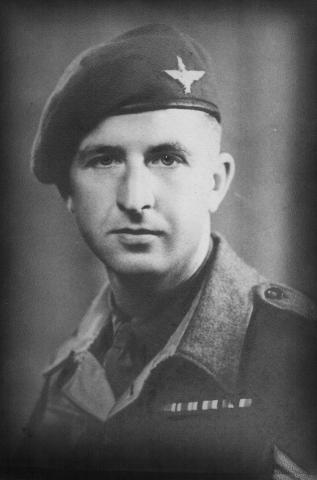
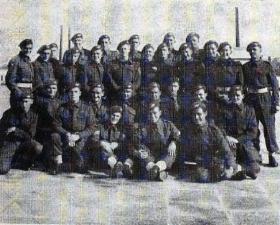
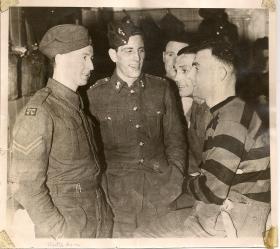
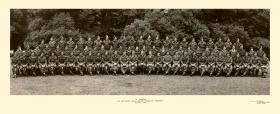
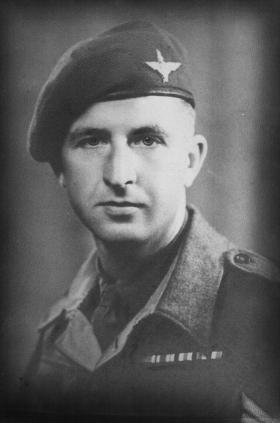
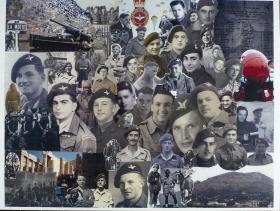
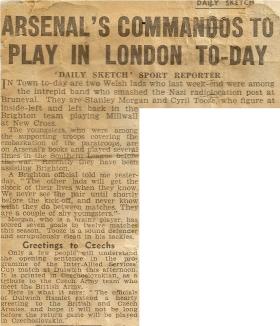

Latest Comments
There are currently no comments for this content.
Add Comment
In order to add comments you must be registered with ParaData.
If you are currently a ParaData member please login.
If you are not currently a ParaData member but wish to get involved please register.